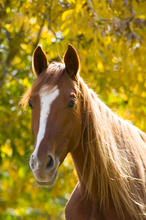 When it comes to parasite control, most horse owners gravitate toward a scorched earth policy - no parasite shall be left standing. With the development of the safe and effective oxibendazole dewormers in the 1960s, and the subsequent release of Ivermectin as a broad-spectrum, easily administered paste, horse owners have felt, for nearly half a century, that they are winning the war against equine parasites. But, parasites are fighting back.
When it comes to parasite control, most horse owners gravitate toward a scorched earth policy - no parasite shall be left standing. With the development of the safe and effective oxibendazole dewormers in the 1960s, and the subsequent release of Ivermectin as a broad-spectrum, easily administered paste, horse owners have felt, for nearly half a century, that they are winning the war against equine parasites. But, parasites are fighting back.
The horse's parasites have evolved beyond the pharmaceutical battleground of the 60's, and horse owners must do the same. The life cycle of Strongylus vulgaris, the large strongyle, once the most common and dangerous equine parasite, provided the model for the --8 week rotational deworming recommendation. Our drugs worked. S. vulgaris has been overthrown. However, the reign of the large strongyle has been replaced by a different, more insidious empire, that of the cyathostomin, or small strongyle.
Small strongyle has some nasty weapons, and he isn't afraid of mere chemicals. However, with the well-prepared arsenal of a strategic deworming program, the small strongyle and his allies can be kept at bay.
Risk Factors for Parasitic Disease:
- Age
- Housing
- Feeding
- Stocking Density
- Manure Removal
- Predisposition - immunity/genetics, high shedders
- Concomitant illness/stress
- Geography/climate
- Quality of Parasite Surveillance and Control
A closer look at disease and risk
Whether the causative agent is a prion, protozoa, virus, bacteria, or parasite, disease depends upon two factors: immunity and exposure. For most diseases, individuals with the least competent immune systems - the very young, the very old, those that are chronically ill, stressed, or malnourished - are most susceptible to infection and subsequent disease. An important distinction lies in that previous sentence; infection does not necessarily equal disease.
With parasite-related disease, this distinction is particularly true. The average, healthy, adult horse actually has a very low risk of disease caused by parasitism. Young horses are most at risk for severe parasitic disease, followed by horses with concurrent illness, malnutrition, or stress.
There is a possibility that the immune-compromise associated with extreme age could put a horse more at risk for parasite-related disease. Given that fecal analyses show that a low percentage of horses shed most of the parasites in a pasture, it is likely that genetics plays a role in parasite resistance.
Exposure is the other arm of disease. When exposure to a disease-causing organism overwhelms immunity to that organism, disease occurs. Since we do not yet have methods other than overall good health care for enhancing immunity to parasites, humans can most affect parasite exposure through management practices.
Since most internal parasites are acquired by a horse eating infective larvae while grazing on contaminated ground, and most parasite eggs or larvae are shed onto the ground in the horse's feces, manure control is critical. The greater the stocking density (# of horses per area), the greater the fecal contamination. Regular manure removal helps prevent pasture contamination. If manure is composted, the pile must reach a specific internal temperature for a specific period of time in order to destroy parasite eggs and larvae.
Climate affects parasite life cycles, as some parasites may be more vulnerable to hard freezes, and variations in temperature and moisture.
The primary weapon used to reduce equine parasite exposure is the dewormer, or anthelmintic. An anthelmintic is a drug class that kills adult or larval helminths (round, as opposed to flat, worms.) Traditional recommendations have involved the regular use of an anthelmintic in every horse, generally at 6-8 week intervals. Various schemes for rotation between drug classes have been proposed. However, the old rules may no longer apply…
Refu--what? A natural population of parasites?
If parasites cause disease, then it follows that all parasites, any parasites are bad, right? Hang on. Before you adapt a slash-and-burn approach to parasite control, consider the refugia. Refugia is the natural population of parasites residing within a horse/pasture system that are unexposed to a particular anti-parasitic drug. It’s important to remember that horses and parasites have evolved together over thousands of years, and while an excessive parasite burden can cause severe disease, particularly in young or immune-compromised animals, a few parasites will not harm the healthy adult horse.
But why preserve any parasite population? Don't we just want to destroy them all? The problem with a zero-tolerance approach to parasite control is that it is impractical if not impossible. Our anti-parasitic drugs, with a few exceptions, kill only adult worms when given at label concentrations. Larval forms remain within the horse and/or ecosystem even if all animals on the farm are treated at the same time. Add to this the practical considerations of horse movement on and off of the farm and human error in dewormer administration, and one can see how unrealistic a zero-sum game is. And, then there is the resistance question.
Unfortunately, even within a single species, parasites are like any other organism - genetically diverse. Since not all parasites are created equal, our drugs do not have equal effect across a parasite population.
Consider the following illustration:
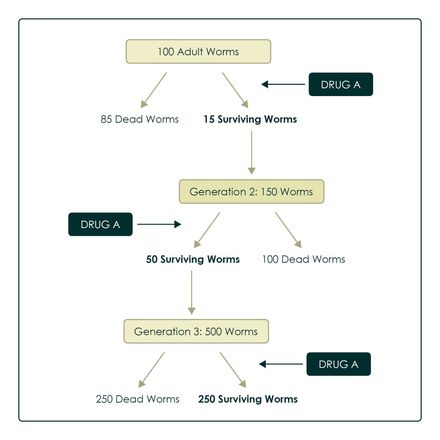
The math in the above illustration is strictly hypothetical, but it is meant to illustrate an important point. If Drug A has a certain efficacy rate on an average worm population, it will kill a set percentage of parasites. However, only the parasites with the greatest ability to withstand Drug A survive and reproduce. They are more likely than the average population to pass along the gene(s) for resistance to Drug A. With each subsequent generation, the likelihood of developing a resistant parasite population increases.
This brings us back to the importance of refugia. If parasites are breeding only with other individuals that have survived treatment with Drug A, the chances of greater resistance to Drug A in the next generation are increased. However, if those parasites co-mingle with a population that has not been exposed to Drug A, the more susceptible individuals of that refugia population will be more likely to pass along genetic information for susceptibility to Drug A and will help to dilute the resistance genes.
Equine dewormer drug classes and drug resistance
A discussion of the importance of refugia leads directly into the problem of anthelmintic resistance. Although a vast array of deworming products greets consumers as they browse shelves, catalogues, and web pages, there are only 3 classes of anthelmintic approved for equine use: avermectin/ivermectins, benzimidazoles, and pyrantel salts. With the exception of moxidectin (Quest), most of these drugs have been in play for 30-50 years.
For these drugs, age is taking a toll. Significant resistance to the benzimidazoles (fenbendazole, oxybendazole) among small strongyles is seen when the drug is given at the label dose. Small strongyle resistance to pyrantel pamoate is beginning to show in the U.S. While equine strongyle resistance to ivermectin has not yet been documented in the U.S., early warning signs such as earlier fecal egg reappearance rates after ivermectin treatment and reports of ivermectin resistance in ruminant strongyle populations are there. Populations of ivermectin-resistant roundworms have been reported in the United States.
Unfortunately, drug development is costly and time consuming, so for the near future, the current arsenal against equine parasites is likely to be the only arsenal. This means that as horse owners, we need to get smarter about our deworming programs.
What about dewormer rotation?
Rotation between classes of dewormer has been recommended as a means of decreasing resistance. Intuitively, this would seem appropriate. The problem, however, is that there is no evidence that rotation decreases resistance. In fact, exposing parasite populations to multiple drugs without checking efficacy may actually be creating resistant populations. Time is not on our side. With only three classes to rotate between and decades of use, genetic selection toward resistance is almost inevitable.
Strategic deworming - A better strategy
Every horse needs to be dewormed routinely, right? Isn’t it cheaper to buy a tube of dewormer than to have a horse checked for parasites by the veterinarian? Not necessarily.
Recent research has shown that approximately 20% of horses shed 80% of the parasite eggs found in a pasture. What this means is that if we deworm every horse every six weeks, we are drastically over-treating many horses, and under-treating some. Factor in the growing threat of drug resistance, and we are setting ourselves up for parasite control failure.
A better strategy is referred to as strategic deworming. Strategic deworming involves:
- Identifying"“high shedders" - recognizing which horses are likely to be passing the largest number of parasite eggs
- Identifying efficacy of each class of dewormer against each type of parasite present on a given farm
- Pinpointing the best time to deworm horses against a particular parasite given the lifecycle of that parasite in your region
Each of these arms of a strategic deworming program requires collaboration with your veterinarian. Your veterinarian can perform a test called a fecal egg count on a sample of your horse's manure to quantify the number and types of parasite eggs being shed. A quantitative analysis (one that gives a number) allows horses to be categorized as high, medium, or low shedders. It is important to bear in mind that horses will shed different levels of eggs depending upon the time since last deworming treatment and the stage of the parasite lifecycle. Therefore, this test should be repeated periodically.
The Fecal Egg Count Reduction Test allows you and your veterinarian to learn the efficacy of the classes of dewormer on the particular parasite population of your ranch. By measuring the fecal egg counts of each horse immediately before, and 14 days after, treatment with an anthelmintic drug, your veterinarian can evaluate the degree to which treatment with that drug reduced the parasite load, and whether that drug is effective against a particular parasite on your ranch.
By not routinely deworming every horse at an arbitrary frequency, strategic deworming reduces the frequency of exposure of a parasite population to a given drug and therefore provides some protection for a population of refugia.
Knowing which horses are shedding the largest numbers of parasites, what parasites are common in your horse population, which drugs are most effective against those parasites on your ranch, and how your climate affects parasite lifecycles will give you and your veterinarian the tools to protect your horses from parasitic disease.
Special circumstance deworming FAQs:
My horse is on a daily dewormer. Do I still need to have fecal testing done?
YES. Without performing a fecal egg count before you begin a daily program, you have no way of knowing whether your horse is a high, moderate, or low shedder. He may not need those expensive little granules at all! Also, resistance to parasites varies with parasite population. If the parasites on your ranch are being exposed to low doses of a single drug on a daily basis, it is particularly important to periodically evaluate the drug efficacy.
What about tapeworms?
Tapeworms are most susceptible to a drug called praziquantel. Many anthelmintic formulations are now made with the addition of praziquantel. Consult with your veterinarian about the best time of year to deworm against tapeworms in your region.
What about encysted small strongyles? I heard they don’t show up on fecal egg counts.
It is true that encysted strongyles exist in the larval form and thus do not lay eggs. However, strongyle larvae do not emerge from a void. Proper, consistent screening of animals in a pasture or group will reveal which horses are carrying large numbers of egg-shedding adults. These high-shedders ideally will be targeted to keep them from contaminating the pasture with high loads of eggs which hatch into the infective larvae.
If most anthelmintics kill only adult worms, is there anything I can use to treat encysted strongyles in my horse?
Two regimens are currently labeled for efficacy against encysted L3 small strongyle larvae. Moxidectin (Quest), an anthelmintic in the same class as ivermectin and a multi-day, double-dose course of fenbendazole (Panacur Power Pac). As with any portion of your parasite control regimen, attempting control of encysted L3 should be done in consultation with your veterinarian.
The parasite players
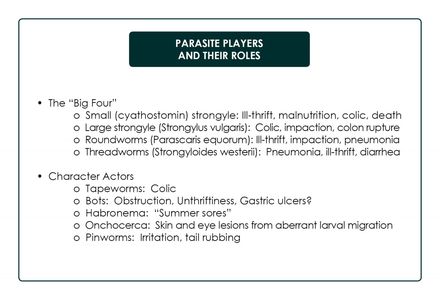
Parasite lifecycles
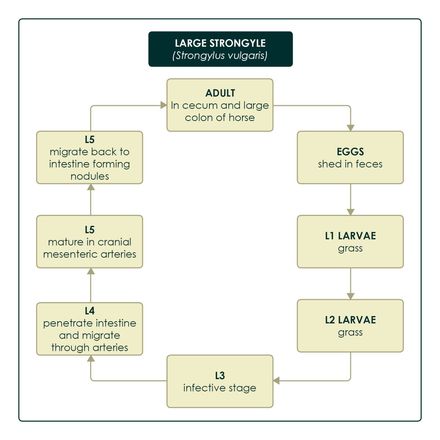
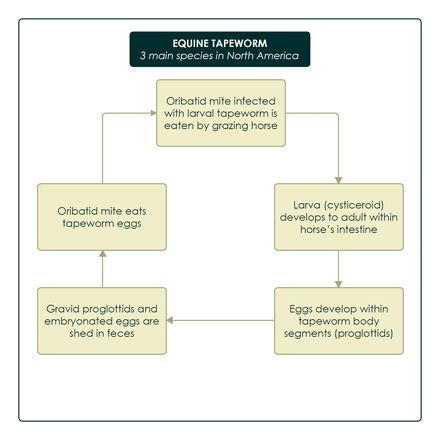
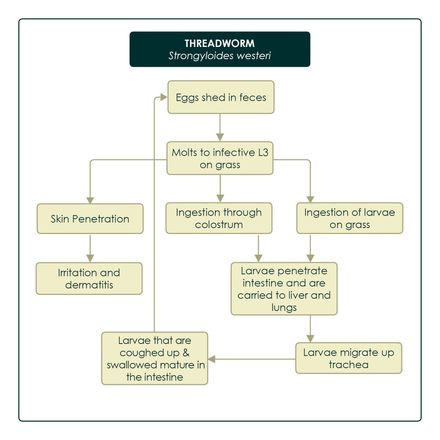
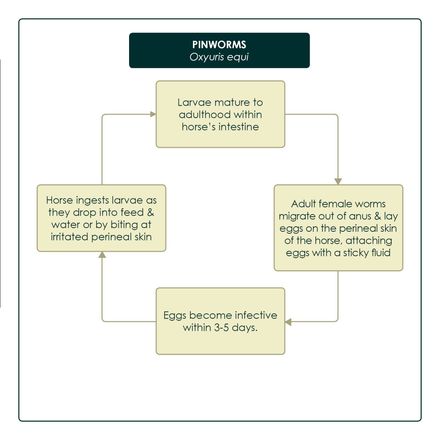
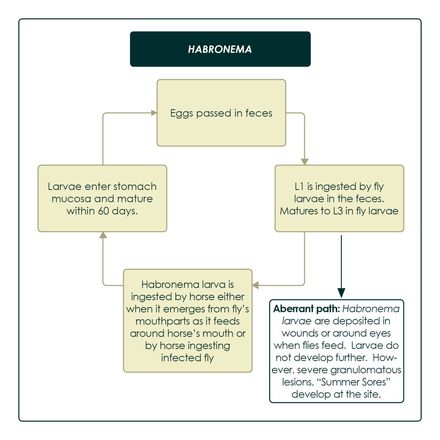
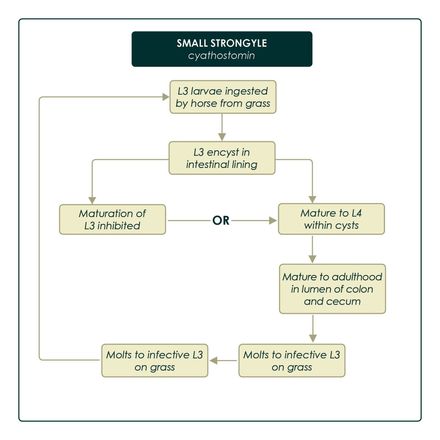
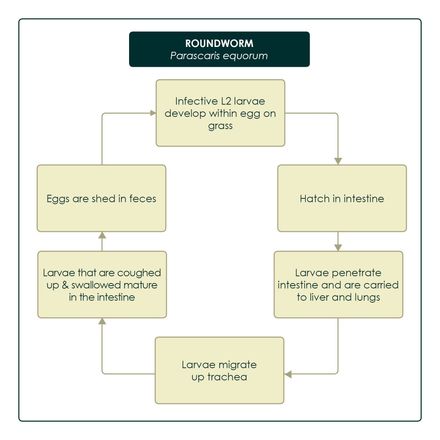
Dig deeperTM
Read Fecal Egg Count Tests Improve Deworming Program for an excellent overview of testing as part of a deworming program.

